Ski Videos: Culture, Evolution, and Impact
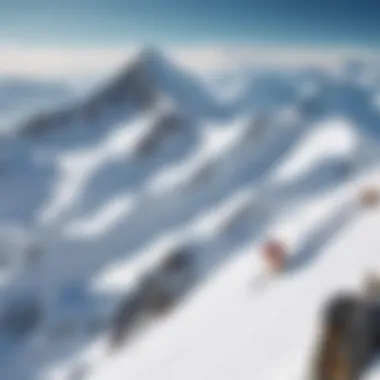
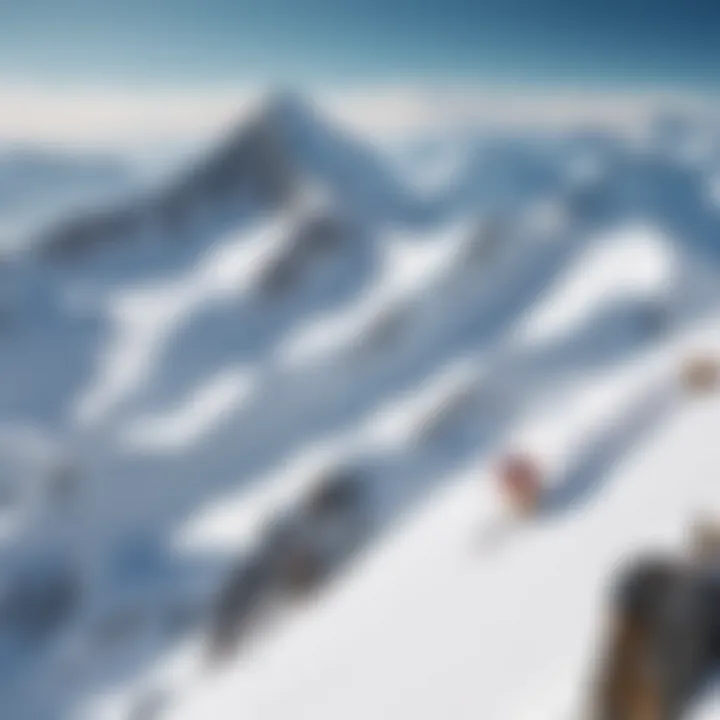
Intro
Ski videos have transformed dramatically over the years, evolving from simple home recordings to complex visual tales that combine stunning cinematography with sports action. This evolution serves not only to showcase the thrilling performances of athletes but also to amplify the entire ski culture around the globe. In a way, these videos meld artistry with athleticism, making every viewing a feast for the senses. In this exploration, we will peel back the layers of ski videos, understanding their impact on the sport, the audiences, and even the technology that breathes life into these visual masterpieces.
Our conversation will navigate various dimensions—focusing on technological advancements in video production, the influence of social media on how such content is shared and perceived, and the inspirational narratives that continue to spark interest among both enthusiasts and newcomers. With each section, we'll uncover insights that illustrate the far-reaching impact of ski videos on the skiing community and culture as a whole.
The Evolution of Ski Videos
The journey of ski videos is not just about capturing breathtaking descents down snowy mountains; it tells the tale of how technology, culture, and artistic vision intertwine to create something far beyond mere footage. Understanding this evolution is essential because it highlights the importance of storytelling within the sport, the rise of community, and the innovative technologies that have emerged along the way. This section sets the stage for a deeper exploration of the aesthetic values and cultural relevance that ski videos carry today.
From Film to Digital: A Historical Overview
The transition from traditional film to digital video editing transformed the ski video landscape into what it is today. Back in the day, skiing films were made using bulky cameras and reels of 16mm film, which artists like Warren Miller and Greg Stump popularized. Their works—though sometimes grainy—captured the raw essence of skiing and the exhilaration it brings.
In the 1990s, with the rise of digital cinematography, the limitations of film were shattered. Filmmakers started to explore faster shutter speeds, pristine resolution, and the ability to edit with precision. This shift opened the floodgates for a new generation of adrenaline junkies to express themselves creatively.
Some key milestones include:
- The introduction of mini DV cameras, allowing skiers to produce their own content easily.
- The advent of YouTube in 2005, which permitted amateur filmmakers to share their experiences with a global audience instantly.
- More recently, the incorporation of drone technology, enabling stunning aerial shots that were once the domain of helicopter filming.
This historical arc—from labor-intensive film projects to accessible digital platforms—has undoubtedly democratized the medium. It has empowered both professional filmmakers and hobbyists to share their unique narratives about skiing, driving the sport into new, imaginative territories.
Pioneering Filmmakers
Certain individuals stand out in shaping the skiing video landscape, crafting a legacy that inspires countless others. Warren Miller, often dubbed the godfather of ski films, set the foundational stone. His unique style blended humor, storytelling, and stunning visuals, capturing the spirit of adventure that resonates with viewers. Miller created films that were accessible and relatable, translating the thrills of skiing into cinematic experiences.
Following his trail were innovators like Greg Stump, whose playful storytelling approach revolutionized how ski action was filmed and presented. Stump added an artistic flair, incorporating music and edits that spoke directly to youth culture. His films like "The Blizzard of Aahhh's" effectively melded ski culture with broader pop culture, ultimately re-shaping perceptions of the sport.
This trend continues today with emerging filmmakers who push the boundaries of cinematography. Let's not forget Anna Segal, whose work emphasizes the technical skills of female skiers, helping to challenge stereotypes and inspire future generations.
These pioneers not only paved the way for technical advancements but also enriched the ski culture, highlighting the diversity and creativity that skiing has to offer.
"Skiing is not just a sport; it is a blend of art and experience, captured beautifully through the lens of passionate filmmakers."
The evolution of ski videos encapsulates a journey marked by creativity, innovation, and community, setting a complex backdrop against which all future developments will unfold.
Aesthetic Considerations in Ski Video Production
The art of ski video production goes far beyond just capturing athletes in action; it's a medium that brings together a variety of artistic elements to engage viewers deeply. Aesthetics play a crucial role in this realm, shaping not only how the audience perceives skiing, but also how they connect with the culture surrounding it. When a ski video is aesthetically pleasing, it becomes more than mere footage; it tells a narrative, captures emotions, and evokes a sense of place that resonates with viewers.
To construct a compelling ski video, several aesthetic considerations come into play:
- Visual Composition: The arrangement of various elements within the frame is paramount. Skiers hurtling down snow-covered slopes against stunning backdrops can create breathtaking visuals. The interplay between the subject and the environment can captivate viewers instantly, inviting them into the experience.
- Color Palette: The colors reflected in the snow, sky, and gear can greatly influence the mood of the video. A vibrant palette can energize a scene, while muted tones can evoke contemplation and serenity. Color grading during post-production enhances the overall feel, giving a cohesive look to the video.
- Lighting: Natural light can be a filmmaker's best friend. The golden hours—early morning and late afternoon—yield soft, diffused light that can make even the simplest scene look magical. Contrast between sun and shade can showcase the terrain texture, making the ski experience more immersive.
"The artistry of ski videos lies in the merger of extreme sports and visual storytelling, crafting a narrative that transcends mere action."
Cinematography Techniques
Diving into the cinematographic aspects of ski video production reveals an array of techniques that can elevate a project from ordinary to extraordinary. Here, movements and angles are meticulously planned to capture the essence of skiing. For instance, using a combination of stationary and dynamic shots can create a rhythm that matches the slalom of the skiers.
- Tracking Shots: Following a skier from behind captures their speed and excitement. This dynamic approach helps the audience feel the adrenaline as if they're racing along right beside the athlete.
- Aerial Shots: Drone technology has transformed the landscape of ski videography. Aerial footage provides a unique perspective, showcasing the sweeping mountain ranges and giving context to the athletes' journey. Close-ups and wide shots together build a fuller picture.
- Slow Motion: By incorporating slow-motion sequences, filmmakers can emphasize specific moments, highlighting technique or the beauty of the landscape. This technique magnifies the artistry within the sport.
Sound Design and Its Importance
While visuals capture the eye, sound design captures the soul of a ski video. The integration of audio can enhance the emotional connection viewers have with what they're watching. A carefully crafted sound environment allows the audience to hear the crunch of snow beneath skis, the whooshing wind, and the thrill of the descent.
- Natural Sounds: Authentic sounds captivate viewers and transport them to the scene. The rustle of trees, the impact of skis on the snow, and even the chatter of fellow skiers create an engaging atmosphere.
- Music Selection: The right soundtrack can elevate a video, setting the pace and tone. Whether it’s a heart-pounding track that embodies adventure or a mellow tune that invites contemplation, music becomes an inseparable element of storytelling.
- Voiceovers and Narration: Adding voiceovers can introduce personal stories or insights from athletes, providing context and enhancing relatability. This layer deepens the connection between the audience and the visuals onscreen.
The Role of Ski Videos in Athletes' Careers
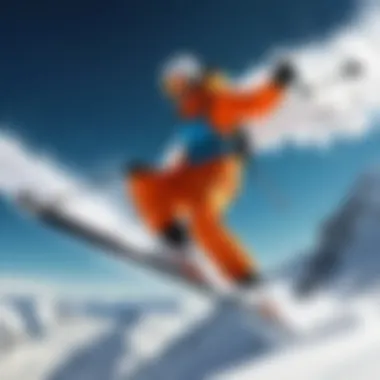
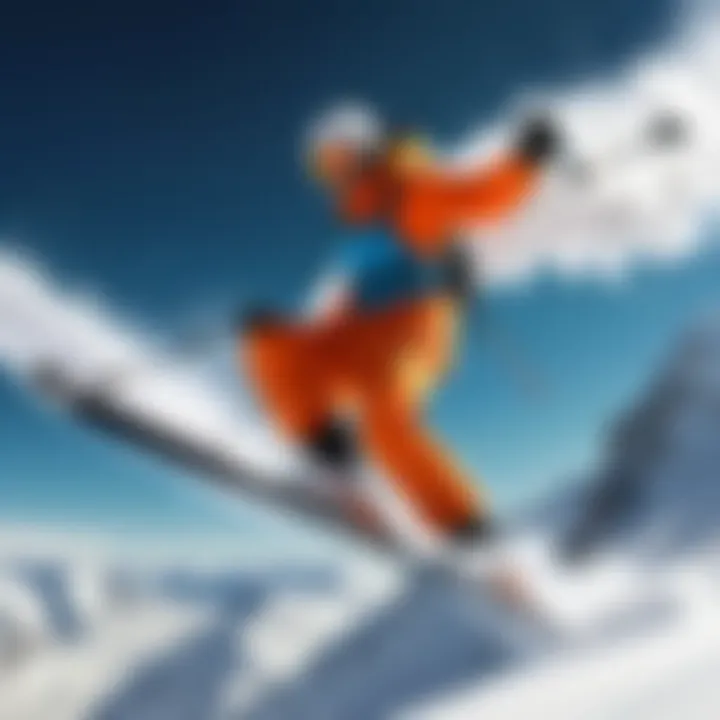
Ski videos hold a significant position in the careers of athletes, acting as a powerful tool to showcase their skills and build their professional identities. In a competitive environment where individuals often vie for sponsorships and media attention, these videos provide an avenue to highlight athletic prowess and engage with fans. By utilizing ski videos effectively, athletes can achieve recognition at various levels, from local to international stages.
Spotlighting Rising Stars
Imagine a young athlete carving through powder on a remote mountain. Their grit and determination are palpable, yet without the right kind of exposure, their talents may go unnoticed. This is where ski videos step in as the perfect platform for emerging talent. With social media and video-sharing platforms, a once obscure skier can reach thousands, or even millions, of viewers overnight.
An example of a rising star is Maddie Mastro, who, through creative and engaging video content, showcased her half-pipe skills and rapidly gained recognition in the skiing community. Aspiring skiers can find similar pathways to success by harnessing video content that highlights their unique styles or exhilarating runs. As such, these videos serve not just as personal showcases but also as a bridge to broader communities and industries, connecting athletes with sponsors and fans alike.
- Visibility: Video content makes it easy for brands and potential sponsors to find and evaluate talent.
- Engagement: Fans become supporters, connecting not just with the athlete’s skills, but their stories and personalities.
- Legacy Building: Ski videos create an archive of an athlete’s career that can be revisited by fans and sponsors over time.
Building Personal Brands
In today’s digital age, having a personal brand is more crucial than ever, especially for athletes. A ski video acts as a digital business card, succinctly capturing not only skiing talent but also the athlete's personality, values, and lifestyle.
An effective ski video can resonate with audiences, making use of visual storytelling and emotional arcs well beyond mere technical prowess. For instance, Jamie Anderson, a well-known personality in the skiing world, utilizes her video presence not just to showcase her skills but to share her endeavors in sustainability, thus resonating with like-minded fans and brands.
Here are some aspects to consider:
- Authenticity: Authentic content fosters trust and a more profound connection with the audience.
- Content Diversity: Video can blend various forms of content—training clips, behind-the-scenes moments, lifestyle segments—that together paint a richer picture of the athlete.
- Collaborations: Partnering with other creatives or brands in ski videos can expand reach and elevate content quality, making both the athlete and their sponsors more appealing.
The effectiveness of a ski video is often measured not just by views, but by the engagement and community building it fosters.
Ultimately, the role of ski videos in an athlete’s career transcends mere aesthetics. They are about building a narrative, finding a voice, and carving out a space within the skiing community and beyond. As technology continues to evolve, so too will the opportunities for athletes to utilize video in meaningful ways.
Ski Videos as Cultural Narratives
Ski videos do more than just showcase breathtaking stunts and panoramic mountain views. They're a lens into the cultural fabric of skiing communities. These visual stories capture the essence of skiing as both a sport and a lifestyle, weaving together narratives that represent a shared identity among skiers. They serve as a powerful medium for expressing values, traditions, and the collective experiences that define skiing cultures across the globe.
Through ski videos, filmmakers can reflect local customs and ideologies while also addressing broader themes of adventure, resilience, and environmental consciousness. For many viewers, especially those who resonate with ski culture, these narratives evoke strong emotional connections. They might feel nostalgic about a favorite ski resort or inspired by the tenacity of an athlete overcoming the odds, thus educating a wider audience about the skiing experience itself.
"Ski videos are not just for thrill-seekers; they're a new type of storytelling that captures life's highs as only mountain culture can."
Representing Community and Identity
Within the realm of ski videos, the representation of community and identity shines through in various forms. Filmmakers often spotlight local ski scenes, delivering a sense of belonging and pride associated with these microcosms. Whether it's an intimate portrayal of a small-town ski club or the bustling energy of a major ski festival, these videos anchor viewer sentiment to their locales and the people who inhabit them.
Ski videos can also bridge generational gaps. Older generations watch the evolution of skiing through these films, finding joy in striking parallels with their own experiences. Through artistry and storytelling, filmmakers forge a path toward understanding and appreciation across ages.
The sense of community is often reinforced by showcasing events like competitions thought provoking beyond mere athleticism. They emphasize teamwork and camaraderie, celebrating those who support the athletes behind the scenes. Skiing becomes a communal experience, embodying the values of trust and cooperation among friends and family. The cultural narratives increasingly celebrate diversity and inclusion. Different backgrounds and personal experiences of athletes come to light, creating a rich tapestry of stories that resonate widely, making ski culture more accessible.
The Global Ski Community
Ski videos play a significant role in knitting together a global ski community. With trips beyond borders becoming more common, these narratives enable viewers to explore ski cultures from diverse perspectives. For instance, a ski video featuring the slopes of Japan can offer insights into unique customs around snow sports, while showcasing the contrasts with Western skiing practices.
By utilizing platforms like Instagram and YouTube, ski video creators effectively connect enthusiasts worldwide. This digital landscape fosters dialogue and collaboration, drawing in individuals from all corners of the earth, creating partnerships and friendships that transcend geographical limits. It also encourages skiers to embrace different styles, grooming a culture of innovation amongst skiers worldwide.
As technology advances, the barriers separating snow sports communities continue to dissipate. Drone footage can capture remote mountainous terrains in spectacular fashion, showcasing not only the beauty of the landscapes but also the innovative spirit that binds skiers together. The global skiing community thrives on shared experiences. Video footage from one country can motivate athletes and fans in another, encouraging them to participate and even compete on an international scene.
Technological Advances Shaping Ski Video Production
The world of ski videos has undergone a radical transformation thanks to technological advances. The ability to capture stunning visuals and tell compelling stories has never been easier or more accessible. In an age where everyone seems to have a high-definition camera in their pocket, the landscape of ski video production has shifted dramatically. This section delves into the specific technologies that are shaping the way filmmakers create and share their work.
Drone Photography in Ski Filming
Drones have become a game-changer in ski filming. With the capability to soar high above the mountain peaks, these flying devices offer a perspective that was previously unreachable for most filmmakers. They enable the capturing of vast landscapes, allowing viewers to appreciate the breathtaking beauty of nature in a unique way. Filmmakers can pinpoint athletes in action against the backdrop of stunning alpine vistas, enhancing the drama of every descent.
A few key points to consider:
- Versatility: Drones can fly in a range of conditions, capturing everything from bright sunny days to exhilarating snowstorms.
- Cost-Effectiveness: Previously, aerial photography required expensive equipment and expertise. Nowadays, drones provide a more accessible option for creators on a budget.
- Safety: When filming risky maneuvers, drones eliminate the need for a human camera operator to be in dangerous positions, thereby keeping everyone a bit safer.
However, while drones can provide spectacular footage, they come with their own set of challenges. Regulatory issues, for instance, can vary widely by region, and operators need to understand these limitations to avoid penalties. There’s also the skill required to operate them effectively. Flying a drone is not just point-and-shoot; it involves understanding angles, compositions, and, sometimes, the unpredictable nature of mountain weather.
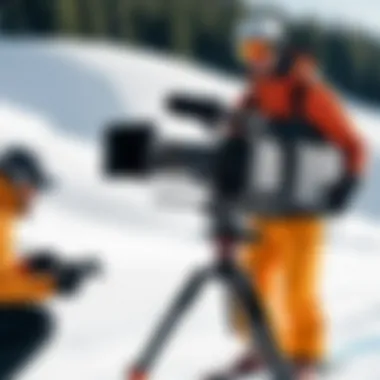
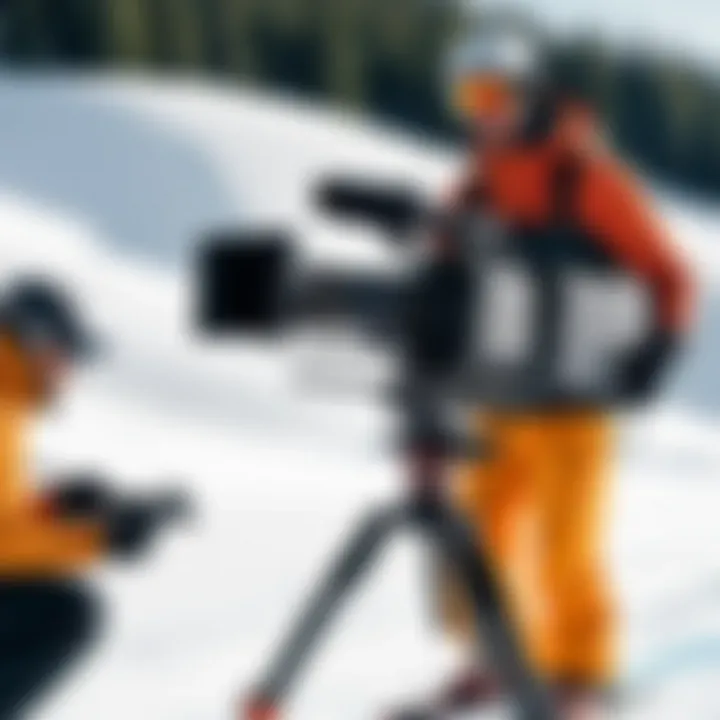
"Drones have opened a new aerial frontier in ski videography, allowing filmmakers to reimagine their stories from previously impossible angles."
Action Cameras: A New Perspective
Action cameras, like GoPro and DJI Osmo, have revolutionized ski videos by putting incredible power into the hands of individual athletes. These compact devices are designed to capture thrilling action while being lightweight enough to mount almost anywhere on a skier’s body or equipment. With their built-in stabilization technology and wide-angle lenses, they can capture immersive experiences that draw the audience directly into the action.
A few important considerations include:
- Durability: Built to withstand harsh conditions, these cameras are perfect for the rugged environment of the mountains.
- Affordability: They are generally much cheaper than traditional filming equipment, making them accessible for hobbyists and professionals alike.
- User-Friendly: Many action cameras are designed for ease of use, enabling users to focus more on their performance rather than fiddling with settings.
The introduction of these cameras has led to an influx of content from amateur filmmakers. Skiers can now document their rides, share their experiences, and even influence trends within the skiing community. However, the challenge lies in discerning the sheer volume of footage; not all action shots are created equal. Effective editing and storytelling can help in sifting through excess content to present engaging narratives that resonate with audiences.
In summary, both drone photography and action cameras have made a lasting impact on ski video production. They bring new opportunities for creativity, while also posing challenges that require skilled handling. As technologies continue to evolve, the dizzying heights of innovation in ski video production promise to unlock even greater potential.
The Influence of Social Media on Ski Video Trends
Social media has turned the landscape of content sharing completely on its head. Ski videos, once confined to niche audiences through limited distribution channels, now reach vast and diverse followers. This turn of events isn't just a fleeting trend; it is a structural change in how we engage with snow sports. With platforms like Instagram, TikTok, and YouTube at the forefront, these videos build community, inspire awe, and even drive the skiing industry forward.
Lauded as a double-edged sword, social media certainly enriches the culture of skiing. It has fostered connections among skiers regardless of location. However, it also creates a race to produce content that can garner attention.
Platforms That Promote Ski Content
Numerous platforms cater to ski enthusiasts, each offering unique advantages for showcasing videos:
- YouTube: Known for its long-form content, YouTube has become a treasure trove for detailed ski documentaries, gear reviews, and instructional videos. Ski profiles thrive here with channels developed by passionate creators.
- Instagram: Often visual and immediate, Instagram allows skiers to share breathtaking images and short clips, drawing immediate engagement. The Stories feature further drives participation, with users sharing their daily adventures.
- TikTok: With its bite-sized video format, TikTok’s algorithm helps ski content go viral in an instant. This platform appeals particularly to younger audiences, ushering in a new generation of ski lovers.
One could argue that these diverse platforms have democratized the ski scene, granting anyone with a smartphone the ability to share their talent. However, this also raises questions about authenticity versus the quest for likes and views. It may lead some athletes to compromise their artistry for trend-chasing.
The Rise of Influencer Culture
As skiing and snowboarding gain traction on social media, so does the phenomenon of influencer culture. These individuals have a knack for captivating audiences, often blurring the lines between professional athlete and content creator. They showcase their skills, engage followers with daily life, and promote brands, accelerating trends in ways traditional marketing could struggle to achieve.
Consider, for instance, athletes like Kimmy Fasani or Chris Benchetler. Both have made names for themselves not just through remarkable feats on the slopes but also by forging connections online. They powerfully illustrate how an influencer’s social media presence can shape narratives in the skiing world. Influencers often foster loyalty, with fans eager to engage based on the narratives they share.
The impact of influencers extends beyond mere fan engagement; they can persuade followers to try new gear or even visit specific resorts. However, the underlying question remains: can the inherent connection crafted with followers be sustained when influencer marketing prevails? With many followers placing trust in these figures, the responsibility increases—skiers need promoters who genuinely reflect their experience.
"Ski videos aren't just about showcasing skills; they encapsulate an experience and community that transcends geographical borders."
In summary, the influence of social media on ski video trends cannot be overstated. With the rise of various platforms, skiers are now interconnected in an unprecedented way, allowing for storytelling, brand promotion, and a community that thrives. Amidst this backdrop, the rise of influencers remains complex—captivating yet laden with responsibilities. The ski world, shaped significantly by these digital narratives, has vast implications for its future.
Ski Video Genres and Their Characteristics
When we talk about ski videos, what really sets them apart is their variety of genres. Each genre brings its own flavor to the table, shaping how audiences connect with the sport and witness the incredible athletic feats captured on camera. Understanding these genres isn’t just for filmmakers; it’s crucial for viewers too, as it enhances their appreciation of the artistry and intent behind each video. Whether one is looking for adrenaline, storytelling, or visual beauty, the genre dictates the experience. Below, we delve into three prominent ski video genres that stand out in this vibrant realm.
Documentary Style
Documentary-style ski videos serve as an exploration of the sport, often diving into the lives of the athletes, their passions, and the environment they operate in. This genre frequently encapsulates interviews, behind-the-scenes moments, and a real sense of journey. When viewers engage with these videos, they get a glimpse into the commitment, struggles, and triumphs of skiers, making it easier to relate.
For instance, take the film "The Ordinary Skier"—it’s not just about the action, but about everyday individuals and their love for skiing. It tells their stories, fosters emotional connections, and places ski culture within a broader social context.
Key Features:
- Personal narratives that showcase individual experiences
- Authentic representations of the ski lifestyle
- Enhanced emotional resonance through storytelling
Action-Packed Clips
On the other end of the spectrum, action-packed clips are the adrenaline junkie's paradise. These videos prioritize the thrill of skiing down steep slopes, executing impressive tricks and captures the high stakes and fast-paced nature of the sport. The camera angles are often dramatic, showcasing skiers navigating powder-filled terrains or launching off massive jumps.
An excellent example is the popular series "TGR’s (Teton Gravity Research) The Dream Factory,” where viewers are treated to relentless action woven with breathtaking landscapes. Here, the focus is less on storytelling, and more on the excitement and the physics of skiing—making it an exhilarating watch for anyone craving some heart-pounding visuals.
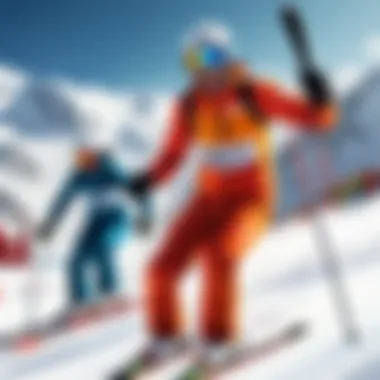
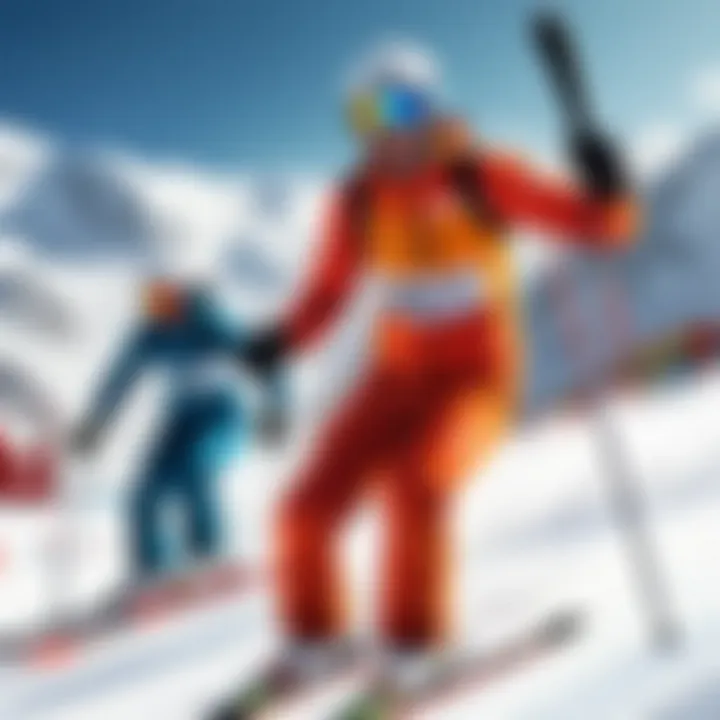
Key Features:
- High-energy footage that keeps viewers at the edge of their seats
- Emphasis on skill and technical prowess of skiers
- Use of dramatic music and editing to enhance the experience
Artistic Interpretations
Artistic interpretations of ski videos break traditional molds, using unique storytelling techniques and innovative cinematography to convey the beauty of the sport. These videos often incorporate elements of artistry, blending slow-motion shots, vibrant color palettes, and evocative sound scores. What sets them apart is their ability to transcend mere sport; they evoke emotion and aesthetic appreciation for skiing.
Consider the works of filmmakers like FWT (Freeride World Tour), whose artful perspective transforms competition footage into visual poetry. Here, skiing becomes a vehicle for expression, showcasing not only the sport but the connection between man and nature.
Key Features:
- Unique visual storytelling that elevates the skiing experience
- Creative use of music and visuals to evoke emotions
- Focus on the aesthetic harmony between the athlete and the environment
Each genre of ski video plays a vital role in broadening the narrative around the sport. From telling personal stories to showcasing high-octane action and artistic visions, the diversity in styles allows audiences to engage with skiing in multifarious ways. As technology evolves, these genres are likely to continue to grow and adapt, further enriching the ski video landscape.
The Impact of Environmental Awareness in Ski Videos
In recent years, the topic of environmental awareness has gained considerable traction in various media, and ski videos are no exception. The rising concern for climate change and its repercussions has prompted filmmakers to weave environmental themes into their narratives. This shift not only serves an important ecological purpose but also resonates deeply with audiences who are increasingly aware of their surroundings. Ski videos often set the stage against the breathtaking backdrop of snowy mountains, allowing viewers to not just witness thrilling performances but also appreciate and reflect on the pristine nature that surrounds them. By promoting awareness of environmental issues, ski videos become more than mere entertainment; they evolve into calls to action.
Promoting Conservation Efforts
Ski videos have a unique capability to spotlight conservation efforts in various ways. One prevalent method is through partnerships with environmental organizations. When filmmakers choose to promote initiatives such as sustainable skiing, wildlife conservation, or climate action, they create a synergistic relationship that elevates both the sport and the environment.
For example, segments may feature local activists engaging in habitat restoration projects or highlight ski resorts committed to using renewable energy sources. This multifaceted portrayal cultivates a sense of duty among viewers to consider their impact on the environment. The visuals of stunning landscapes juxtaposed with messages about preserving these locations can linger in people's minds long after viewing, inspiring action.
Here are some impactful ways ski videos promote conservation:
- Highlighting Sustainable Practices: Showcasing resorts that prioritize eco-friendly practices can encourage others to follow suit.
- Raising Awareness of Environmental Challenges: Informing viewers about issues like melting glaciers or deforestation can spur conversations about climate change.
- Inspiring Community Engagement: Featuring events that involve the local community in conservation work can foster a communal bond over environmental stewardship.
Capturing the Beauty of Nature
The allure of skiing lies not just in the thrill but also in the enchanting beauty of untouched snow and majestic mountains. Ski videos excel at capturing these elements, presenting viewers with visual feasts that frequently invoke a deep emotional response.
The way filmmakers employ cinematography to showcase the natural environment is nothing short of artistry. With drone shots soaring over glistening peaks or close-ups of snow-laden branches, they create a narrative that harmonizes human activity with nature's splendor. This aesthetic serves as a reminder of what is at stake if we do not protect our environment.
Utilizing ambient sounds combined with the visuals can also enhance this experience, drawing viewers into the scene as they hear the soft crunch of powdery snow beneath skis or the rush of wind on a peak. This sensorial combination makes the call for environmental awareness not just a juxtaposition but a tangible experience.
Key Takeaways:
- Visual Storytelling is Key: Effective ski videos narrate stories that intertwine the sport with the landscape, elevating awareness.
- Emotional Connection: Cinematic beauty transitions into a call for action, urging viewers to reflect on their role in environmental conservation.
- Cultural Impact: Promoting awareness fosters a collective identity among skiers that respects and protects the environment they love.
"The mountains have their own language, and when captured through the lens of a camera, they can speak volumes about our responsibility to them."
By interlacing themes of environmental awareness into ski videos, filmmakers harness their audiences' emotions and inspire them to become advocates for preservation, ensuring that future generations can enjoy the same breathtaking experiences.
Future Directions for Ski Videos
The landscape of ski video production is in a state of constant transformation, influenced not only by advancements in technology but also by changes in viewer preferences and societal norms. Understanding the future directions for ski videos is pivotal for appreciating how they might evolve and serve a broader audience. As the industry embraces fresh ideas and innovative techniques, it opens doors for enhanced storytelling, audience engagement, and an enriched viewing experience.
Emerging Filmmaking Techniques
As ski videos transition into the future, we can expect filmmakers to adopt a multitude of new techniques that push the boundaries of visual storytelling. Some of these emerging methods include:
- 360-Degree Filming: This technique allows viewers to experience the action from all angles. Imagine skiing down a pristine slope and having the freedom to look around as if you were actually there. This immersive quality could profoundly change how enthusiasts engage with the sport.
- Time-Lapse and Hyperlapse: Capturing the majesty of mountain landscapes over extended time frames brings a new dimension to ski videos. Time-lapse sequences can effectively showcase the changing weather, highlighting the beauty of conditions that make skiing possible. Hyperlapse, on the other hand, creates dynamic sequences of skier movements that appear almost dreamlike.
- Augmented Reality (AR) Integrations: AR could introduce layers of interactivity to ski videos, giving viewers real-time data about snow conditions, geographical features, or ski techniques. This not only educates the audience but also enriches the overall experience while watching.
By embracing these techniques, filmmakers can craft narratives that resonate in unique ways with their audience, offering both visual delight and informative content.
Interactive and Immersive Formats
The demand for personalized and engaging viewing experiences is on the rise. Consequently, ski videos are likely to lean heavily into interactive and immersive formats. These are some avenues being explored:
- Choose-Your-Path Narratives: This format allows viewers to make choices that affect the storyline or perspective of the video. Imagine selecting between following a seasoned athlete on a challenging descent or a beginner navigating their first run. This option not only adds a layer of interactivity but also caters to a wider audience by offering tailored experiences.
- Virtual Reality Experiences: With the advancement of VR technology, filmmakers can create fully immersive environments where viewers feel as though they are skiing without stepping onto the slopes. This goes beyond traditional viewing and places the audience right in the heart of the action.
- Community-Driven Content: The future also looks toward collaborations with ski enthusiasts worldwide. Platforms could encourage users to upload their footage, creating a tapestry of skills, locations, and styles. This community engagement enriches the content pool and fosters a sense of belonging among viewers.
"The future of ski videos isn’t just in what we see, but how we experience it. The more interactive and immersive they become, the more connected we feel to the sport and each other."
By emphasizing interactive and immersive formats, the ski video industry not only appeals to the consumer's desire for engagement but also crafts a more participatory experience in the vibrant culture of skiing.







